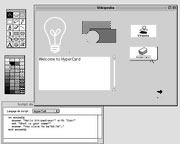HyperCard - Dynamic Programming - 1987
The human mind does not work that way. It operates by association. With one item in its grasp, it snaps instantly to the next that is suggested by the association of thoughts, in accordance with some intricate web of trails carried by the cells of the brain. It has other characteristics, of course; trails that are not frequently followed are prone to fade, items are not fully permanent, memory is transitory. Yet the speed of action, the intricacy of trails, the detail of mental pictures, is awe-inspiring beyond all else in nature. - Vannevar Bush, "As we may Think" in The Atlantic Monthly, 1945.
 Apple computer introduces hypertext to the public with their Hypercard application in 1987 that is designed to run on the Macintosh (Mac) computer. It was created by Bill Atkinson. The software's power lies in its ease of use — information is stored in a series of “cards,” arranged into “stacks.” The cards can be linked to each other, just like the hypertext links used on the Web. A built-in, plain-English programming language, HyperTalk, executes commands. Each card has unique information on it and shares elements with other cards via the background.
Apple computer introduces hypertext to the public with their Hypercard application in 1987 that is designed to run on the Macintosh (Mac) computer. It was created by Bill Atkinson. The software's power lies in its ease of use — information is stored in a series of “cards,” arranged into “stacks.” The cards can be linked to each other, just like the hypertext links used on the Web. A built-in, plain-English programming language, HyperTalk, executes commands. Each card has unique information on it and shares elements with other cards via the background.
When compared to a database, each card is a single record and has one or more fields that store information or data. These fields link to other cards within the stack. The stack is the database file. But unlike most databases, the HyperCard database is quite graphical, thus it becomes a unique tool for accessing a database of information in a nonlinear fashion.
I have realized over time that I missed the mark with HyperCard, I grew up in a box-centric culture at Apple. If I'd grown up in a network-centric culture, like Sun, HyperCard might have been the first Web browser. My blind spot at Apple prevented me from making HyperCard the first Web browser. - Bill Atkinson
HyperCard has had a huge impact on the Internet as it inspired the creation of both HTTP and JavaScript.
Hyper...
Ted Nelson coined the terms hypertext and hypermedia in his 1965 paper to the ACM 20th national conference:
...by 'hypertext' I mean non sequential writing — text that branches and allows choice to the reader, best read at an interactive screen.
While there were a few other applications that were conceived before HyperCard, but not built, such as Theodore Holm Nelson's Xanadu; or built, such Xerox's NoteCard, none achieved such a widespread popularity as Apple's HyperCard.
Next Step
Return to the Information and Knowledge page


